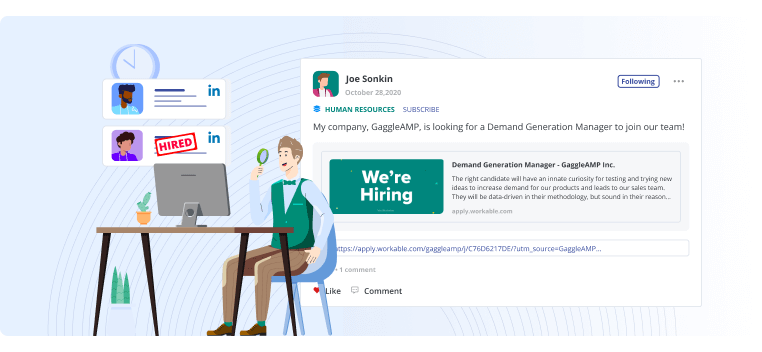45 Social Media Recruitment Statistics You Need to Know
Social media recruitment has become a common practice amongst top recruiters. Thanks to the rise in technological innovation and emerging social media platforms, social media is not just about leisure. It’s a strategic approach to attracting high-quality talent in a competitive hiring environment.
The competitive hiring process is partly fueled by record-high levels of employee resignations. Often termed “The Great Resignation,” there has been a massive exodus from the job market since the beginning of 2021. To be precise, almost 57 million American employees quit their jobs. This highlights a 25% increase in resignations compared to a similar time frame before the pandemic.
The resignation trend peaked in March 2022, when nearly 4.5 million workers quit their jobs in a single month. This is precisely why recruitment has become competitive.
With the rise in options for remote work, employees can work for companies across the world. Even as the pandemic-related restrictions ease, the remote work trend is here to stay.
According to the Ladders Quarterly Remote Work Report, approximately 18% of all professional jobs are now remote. Additionally, in the last quarter of 2021, nearly three million jobs became permanently remote. This rise in remote job opportunities has also contributed to labor turnover as employees can easily change jobs without relocating.
Changing working priorities for employees has put pressure on recruiters. Recruiters need to find talent that is compatible with their existing work culture, and not all applications are.
For example, according to a 2021 LinkedIn survey, workers prioritized the following factors:
1. Work-life balance (63%)
2. Compensations and benefits (60%)
3. Colleagues and culture (40%)
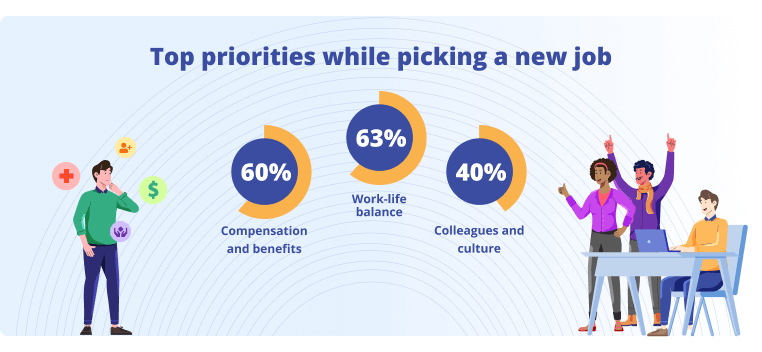
Social media recruitment is a powerful strategy that helps recruiters navigate external labor market factors, such as:
- high employee turnover
- the rise in competition for attracting and retaining talent
- an increase in remote work opportunities
- changing employee preferences
What Are Social Media Recruitment Trends?
Social media recruitment trends help you understand how others are using social media to support their recruitment needs. They give you a broad idea of what works with social media recruiting and how it is beneficial for your business.
Social Media Use Is on the Rise
One of the most significant advantages of using social media for recruitment is the reach it provides. Approximately 58.4% or 4.62 billion people globally, which accounts for more than half of the world population, use social media. While the demographic of each platform differs, this statistic demonstrates the ever-increasing reach of social media.
It's not just the number of people, but also the amount of time spent on social media, that's increasing.
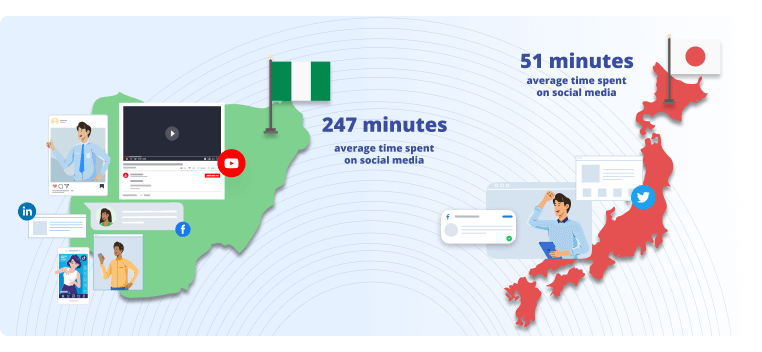
In 2022, the average time spent daily on social media worldwide was 147 minutes. This number differs from country to country, for example:
- Nigerians spent the most time online with an average of 247 minutes
- Japanese people spent only 51 minutes each day
As people engage more with social media platforms, it becomes easier for recruiters to reach out to potential employees.
Social Media Is Extremely Conducive for Recruitment
An increasing number of recruiters are leveraging the power of social media. According to Betterteam, a whopping 94% of professional recruiters use social media to network and post jobs, making it one of the most popular methods of recruiting talent. Recruiters are shifting focus from traditional methods such as employee referrals, job boards, and job ads to social media.
Further, a Society for Human Resource Management study says a large majority of companies use social media for recruitment. In fact, 84% of organizations are currently using social media for recruitment and 9% of those who don’t yet use social media yet are planning to.
On the other side of the market, employees have been using social media to find jobs. According to CareerArc’s 2021 Future of Recruiting Study, 86% of job seekers use social media in their job search. Besides searching for jobs, employees use social media to network and engage with company content.
Brand Reputation Matters
As employees demand more than just good compensation, there is an increasing focus on the brand and reputation of the employer.
Employees want to verify their compatibility with their potential employer before joining the company. 82% of employees consider the employer's brand and reputation before applying. This is a 7% increase over the last five years.
48% of job seekers rank social media as the number one tool to research any company's “deal-breakers.” Examples include:
- lower or unfair pay
- less work-life balance
- a lack of workplace flexibility
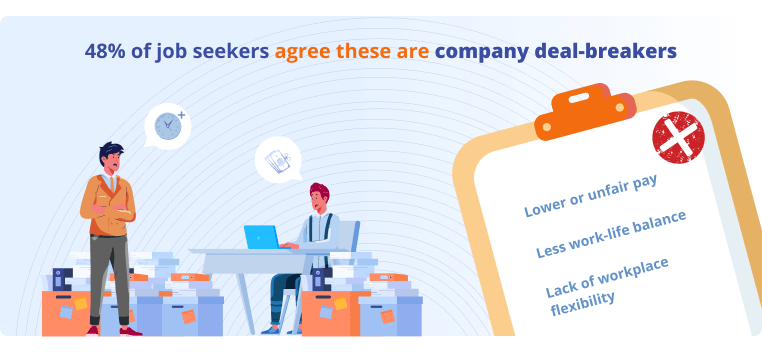
This implies that developing a strong social media presence is crucial for attracting top-quality talent.
There Is Plenty of Scope for Improvement in Social Media Recruitment
Many companies already use social media, but most do not have an effective social media strategy. This is plenty of scope for improvement, which means you’re not too late.
For example, according to a CareerArc study, only 39% of employers target specific audiences (e.g., via hashtags) and only 39% of them involve their employees in sharing branded content. For efficient and effective recruitment, it’s essential to target specific demographics that are best suited for your role and company. Employee-generated content can be helpful here. It's an excellent way to engage future hires and give them a sneak peek into your corporate culture.
Many companies have already realized that there is scope for improvement. According to Jobvite research, 46% of companies said social media recruiting investments are a focus in 2020 and beyond. Similarly, the Career Arc report also highlights that 41% of recruiters said they increased their investment in social media and social media recruiting software in 2021.
Platform Specific Social Media Recruitment Statistics
The right choice of platform depends on the exact demographic you’re targeting. Your target demographic is a function of the seniority level you’re hiring for, job role, industry, location, and more. Different social media platforms have different benefits, making it important to consider your context before using a platform.
Jobvite research shows these are the platforms recruiters report using or are planning to use, in decreasing order of popularity:
- LinkedIn (72%)
- Facebook (60%)
- Twitter (38%)
- Instagram (37%)
- Glassdoor (36%)
- YouTube (27%)
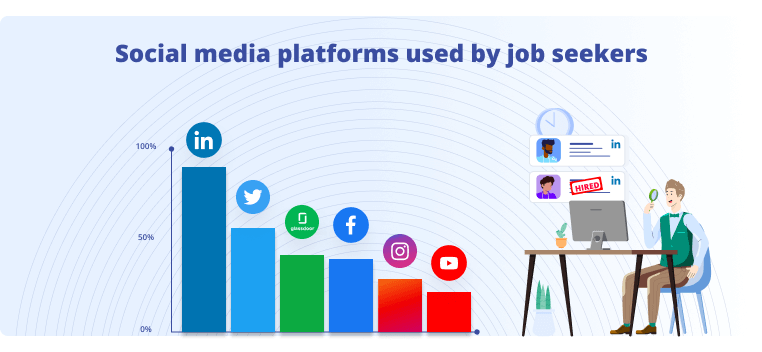 According to the same research, the social channels that source the highest quality candidates are:
According to the same research, the social channels that source the highest quality candidates are:
- LinkedIn (67%)
- Facebook (34%)
- Glassdoor (24%)
- Instagram (23%)
- Twitter (21%)
Also, male recruiters tend to use social media more than female recruiters. 71% of male recruiters use Facebook, compared to only 53% of female recruiters. Similarly, 55% of male recruiters use Twitter, compared to only 28% of female recruiters.
There is a reason LinkedIn is considered one of the leading platforms for recruitment. According to LinkedIn’s official website, there are:
- Over 800 million members from over 200 countries and regions worldwide
- More than 188+ million users in the U.S.
- 95 job applications are submitted every second
- 88% increase in confirmed hires year-over-year in Q3 FY22
- 9 million members using Creator Mode since its launch
- 50 million people who use LinkedIn to search for jobs each week
- 6 people are hired every minute on LinkedIn
- 39,000 skills listed
- 58 million+ companies listed
- 43% year-over-year increase in talent solutions revenue (44% in constant currency) in Q3 FY22
- 22% year-over-year increase in platform engagement in Q3 FY22
Lastly, LinkedIn is exceedingly popular with recent graduates. There are approximately 46 million students and recent graduates on LinkedIn, making it a popular destination for entry-level applicants.
Facebook/Meta
Facebook, now known as Meta, is the most used social media platform in the world. Recruiters love Facebook for its wide reach and ability to cater to every demographic. As of March 2022, Facebook had 1.96 billion daily active users, a 4% increase over last year.
Facebook is quite a popular recruitment tool too. 81% of job seekers want to see opportunities posted on Facebook career pages.
Additionally, 60% of recruiting managers are currently using Facebook to search for talent. Recruiters can create job openings on their business page, making the application process quicker for employees.
Benefits of Social Media Recruiting
Social media recruitment has grown to become a popular strategy because of its multiple benefits. It provides numerous advantages over traditional forms of job recruitment, such as job boards.
Reduce Recruitment Costs

According to the Society for Human Resource Management (SHRM), it costs approximately $4,683 on average to hire a new employee. Don't forget the soft costs of hiring — it can be nearly three times the salary of the position you’re hiring for.
Social media considerably mitigates this cost with its wide reach. Employees and other people in your network can share the job posting. Through word-of-mouth marketing, you get a better quality and quantity of applications.
Cater to Millennials
It’s no surprise that millennials are increasingly representing a larger percentage of the workforce. This is why recruiters have to specifically develop strategies that work for millennials.
68% of millennials visit a company’s social media properties specifically to evaluate an employer’s brand. Further, millennials value various dimensions of the job apart from just their salaries. For example, a toxic work culture is 10.4 times a better predictor than compensation to explain a company’s attrition rate.
It pays to build your social media presence. Using employee-generated content and taking a multichannel approach, you can present your work culture to potential hires. This also reduces the chances of friction in the future.
Access Passive Candidates
Passive candidates refer to those who aren’t actively looking for jobs but might consider a position if it is beneficial for their career. Recruiting passive candidates continues to be an effective strategy recruiters use to attract quality talent.
According to SHRM, 82% of recruiters consider recruiting passive candidates as the top reason to use social media. Betterteam also finds a similar statistic – 80% of employers say social recruiting helps them find passive candidates.
To conclude, these statistics illustrate the broad trends and statistics in social media recruitment that you’ll find helpful. Given the challenging and competing hiring market, it is critical to adapt your strategies to stay competitive and hire quality talent. Social media is one such avenue that can help businesses attract and retain top talent.









